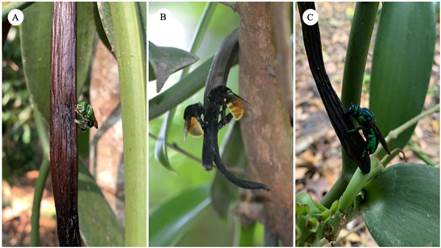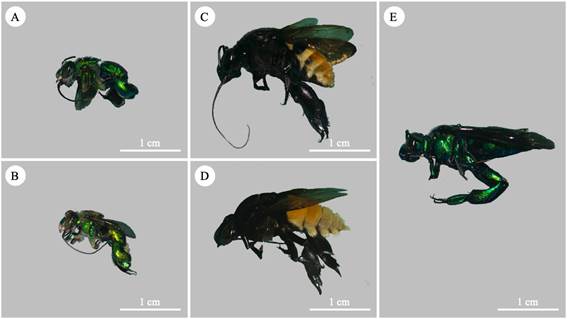Introduction
Orchid bees depend strongly on resources like resins and scents for the construction of nests and attracting mates, respectively (Roubik and Hanson, 2004). It is also known that orchid bees collect scents from non-floral sources, like sap from plant wounds, fruits, and cadavers of other male Euglossine bees (Roubik and Hanson, 2004), as well as from fungi (Cappellari and Harter-Marques, 2010). Scent collection is exclusively performed by male Euglossine bees (Dodson et al., 1969; Roubik and Hanson, 2004). This process consists of scraping the structure surface with their front tarsi followed by fluttering, while the chemical transfers from the front tarsus to the middle tarsi and then to the posterior tibia. Afterwards, the bees land on the source of the scent scraping the surface, repeating this behavior for up to one hour (Roubik and Hanson, 2004). This process of scent collection by male Euglossine bees has been studied for at least five decades (e.g., van der Pijl and Dodson, 1966; Dressler, 1967). More recent studies have focused on the interactions between Euglossine bees and orchid flowers and their fragrances (e.g., Ramírez et al., 2002; Roubik and Hanson, 2004; Hentrich, 2008; Hetherington-Rauth and Ramírez, 2016; Nunes et al., 2017; Milet-Pinheiro et al., 2018; Pansarin et al., 2018).
Chemical baits are being used to attract and identify Euglossine bees. One of the main attractors used is eucalyptol (Dodson et al., 1969; Dressler, 1982; Silva and Rebêlo, 2002; Ferreira et al., 2011; Silva, 2012; Castro et al., 2013; Ribeiro et al., 2015), and vanillin has also been used in chemical baits for euglossines (Williams and Dodson, 1972; Dressler, 1982; Dressler, 1993; Rebêlo and Silva, 1999; Ramírez et al., 2002; Silva and Rebêlo, 2002; Melo et al., 2009; Ferreira et al., 2011; Silva, 2012; Castro et al., 2013; Hinojosa-Díaz and Engel, 2014; Pansarin et al., 2018; Coswosk et al., 2019; Dec and Alves-Dos-Santos, 2019). However, relatively few orchid species naturally produce flowers with vanillin scent (Williams and Dodson, 1972; Gerlach and Schill, 1991). This scent is produced by vanilla fruits, rather than by flowers.
Lubinsky et al. (2006 reported Eulaema cingulata Fabricius, 1804 collecting scents from fruits of Vanilla grandiflora Lindl. (=V. pompona subsp. grandiflora (Lindl.) Soto Arenas) and E. cingulata has been recorded being attracted to vanillin in chemical baits (e.g., Ramírez et al., 2002; Silva and Rebêlo, 2002; Melo et al., 2009; Silva, 2012; Coswosk et al., 2019; Dec and Alves-Dos-Santos, 2019). However, this has not yet been observed in Vanilla planifolia Andrews. Considering that mature fruits of V. planifolia naturally produce vanillin, we hypothesized that E. cingulata will be the species with the highest visiting frequency to collect scents from the mature fruits of V. planifolia. Therefore, the objective was to identify Euglossine species and visitation frequency to mature fruits of V. planifolia.
Materials and Methods
The study was carried out in an experimental Vanilla planifolia plantation established in 2013, which has trees of Inga vera Willd. and shrubs of Coffea arabica L. as live tutors. This plantation is located in Jilotepec, Veracruz, Mexico, at 1000 m above sea level (Fig. 1). Eleven observations were done within a month (March 6 to April 6, 2021) every fourth day. Mature fruits were approximately 12 months old (2020 bloom). Each observation lasted ten hours (8:00 to 18:00), representing a total of 110 hours sampling effort. During our observations we collected individuals of Euglossine bees directly from V. planifolia mature fruits to identify them at species level. Species identification and sex determination were done for each of the collected specimens. Euglossine bees were identified using the taxonomic keys of Roubik and Hanson (2004) and Estrada de L. (2018). We also registered Euglossine bee visit frequency to mature V. planifolia fruits and their behavior through the observations. These visits were recorded with photographs and video using a Nikon D3100 digital SLR camera (Nikon, Tokyo, Japan). Visit frequency data were analyzed using a (2 in R v. 4.0.3 (R Core Team, 2020).
Results
We collected five species (15 individuals) visiting the mature fruits of V. planifolia to collect scents. They belonged to three genera of Euglossine bees (Euglossa Latreille, 1802; Eulaema Lepeletier, 1841; and Exaerete Hoffmannsegg, 1817) (Fig. 2). The five species were Euglossa hemichlora Cockerell, 1917; E. variabilis Friese, 1899; Eulaema cingulata, E. polychroma Mocsáry, 1899 and Exaerete frontalis Guérin-Meneville, 1845 (Fig. 3). All of them were male specimens.

Figure 2: Attraction and collection of scents in mature fruits Vanilla planifolia Andrews. A. Euglossa Latreille, 1802; B. Eulaema Lepeletier, 1841; C. Exaerete Hoffmannsegg, 1817. Photos: M. A. Lozano Rodríguez.

Figure 3: Euglossine species attracted to mature fruits of Vanilla planifolia Andrews. A. Euglossa hemichlora Cockerell, 1917; B. Euglossa variabilis Friese, 1899; C. Eulaema cingulata Fabricius, 1804; D. Eulaema polychroma Mocsáry, 1899; E. Exaerete frontalis Guérin-Meneville, 1845. Photos: M. A. Lozano Rodríguez.
The genus Eulaema reported 72% of the visits to V. planifolia mature fruits (n=211), while Euglossa and Exaerete had 27% and 1% of these, respectively. Eulaema polychroma was the species with the highest visitation frequency (54% of total visits), followed by Eulaema cingulata with 18%. The visitation frequency for Euglossa was not calculated at the species level because of the difficulty to visually distinguish them in this genus without collecting and analyzing each specimen. We were thus only able to identify two species from five individuals that we collected. We found statistically significant differences (Table 1) in the visitation frequency of Euglossine bees (X 2=20.65; gl=2; p<0.001). Exaerete frontalis was not included in the statistical analysis because of its low visitation frequency (1%, n=2).
Table 1: Total visits by Euglossine bees to mature fruits of Vanilla planifolia Andrews recorded during this study on a vanilla plantation in Jilotepec, Veracruz, Mexico. *Not included in the statistical analysis.
| Genus | Species | Visits | Total visits by genus |
|---|---|---|---|
| Euglossa Latreille, 1802 | Euglossa spp. | 58 | 58 |
| Eulaema Lepeletier, 1841 | Eulaema cingulata Fabricius, 1804 | 38 | 151 |
| Eulaema polychroma Mocsáry, 1899 | 113 | ||
| Exaerete Hoffmannsegg, 1817 | Exaerete frontalis Guérin-Meneville, 1845* | 2 | 2 |
Discussion
The individuals of the three genera observed in the mature fruits of V. planifolia performed the typical scent collection behavior described by Roubik and Hanson (2004). This behavior has been recorded for mature fruits of Vanilla pompona subsp. grandiflora (Lubinsky et al., 2006) and V. aff. odorata (Madison, 1981) but, to our knowledge, the present study reported it for the first time for V. planifolia.
According to various studies (Williams and Dodson, 1972; Dressler, 1982; Rebêlo and Silva, 1999; Ramírez et al., 2002; Silva and Rebêlo, 2002; Melo et al., 2009; Silva, 2012; Castro et al., 2013; Hinojosa-Díaz and Engel, 2014; Coswosk et al., 2019; Dec and Alves-Dos-Santos, 2019), the use of vanillin as an attractor has been effective in approximately 179 Euglossine species. Four of these (Euglossa variabilis, Eulaema cingulata, E. polychroma, and Exaerete frontalis) have been observed naturally in our study in mature fruits of V. planifolia. Euglossa hemichlora is the only one that has not been previously reported as attracted to vanillin. Even when E. cingulata is the species that has been more times recorded being attracted to vanillin using chemical baits (Ramírez et al., 2002; Silva and Rebêlo, 2002; Melo et al., 2009; Silva, 2012; Coswosk et al., 2019; Dec and Alves-Dos-Santos, 2019), our field observations found E. polychroma as the bee with the greatest visiting frequency collecting scents from the mature fruits of V. planifolia. Consequently, with these results we reject our hypothesis, as E. cingulata was not the species with the greatest records. Even when both species can be found in Veracruz (Mexico) (Yáñez-Ordóñez and Hinojosa-Díaz, 2004; Bonet and Vergara, 2019; Juárez, 2021), our study shows that E. polychroma is the one who is more attracted to mature fruits of V. planifolia.
Euglossine bees have been reported collecting scents in fruits and pollinating Vanilla flowers (Soto, 1999; Lubinsky et al., 2006; Watteyn et al., 2021), and this study shows that V. planifolia fruits attract orchid bees to collect scents as well. Therefore, it might be the only genus in the Orchidaceae family that has this double interaction with orchid bees. In general, these bees’ visitation frequency to the fragrant fruit of vanilla had not been previously studied in detail. Moreover, the potential role of orchid bees as disperser of the seeds of Vanilla species with aromatic fruits has been suggested (Madison, 1981; Dressler, 1993; Lubinsky et al., 2006; van Dam et al., 2010; Cameron, 2011).
Exaerete frontalis was the rarest species with the lowest visiting frequency to mature fruits of V. planifolia. Similarly, Rebêlo and Silva (1999) and Ramírez et al. (2002) found that Exaerete frontalis is rarely attracted to vanillin. Parasitic genera (like Exaerete) have seldomly been documented to be interacting with orchids (Roubik and Hanson, 2004). However, in this study we were able to observe this unusual interaction between E. frontalis and the mature fruits of V. planifolia to collect scents.
Conclusions
For the first time orchid bees have been registered collecting scents in mature fruits of V. planifolia. The genus Eulaema is strongly attracted to the mature fruits of V. planifolia to collect scents. Eulaema polychroma was the species with greatest attraction and interaction with the mature fruits of V. planifolia, even when E. cingulata was the species with more records of being attracted to vanillin and mature fruits of vanilla. All the species performed the typical behavior of scent collection by orchid bees. The visiting dynamics of Euglossine bees requires further studies to understand their behavior during the process of attraction-visit-collection of scent of the fruit of V. planifolia.











 text new page (beta)
text new page (beta)




